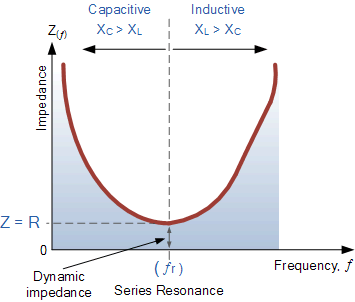1.4 KiB
1.4 KiB
Series RLC Resonance
When we have an Inductive and a Capacitive part in an ac circuit there is a certain frequency when the Impedance of those two parts are equal.
It can be calculated as follows
\displaystyle f_{r} = \frac{1}{2\pi \sqrt{LC}}
This formula is derived from
\begin{flalign}
\frac{1}{2\pi f C} = 2\pi f L \\
f^2 = \frac{1}{4\pi^4LC} \\
f = \frac{1}{4\pi^2LC} \\
\end{flalign}
At this resonance frequency the impedance from capacitor and inductor cancel each other out, which means that Z=R
When we graph out the impedance vs frequency in a circuit, it could look something like this:
This could cause problems because the voltage is really high at that point, which maybe bad for some other parts.
Example:
$ 1 0.000005 30.13683688681966 45 5 43 5e-11
v 256 256 256 128 0 1 10000 5 0 0 0.5
l 432 128 432 256 0 1 0 0
c 256 256 432 256 0 0.000014999999999999999 0 0.001
r 256 128 432 128 0 10
o 1 64 0 4099 5 0.025 0 2 1 3
Lets calculate f_{r} for this circuit.
\begin{flalign}
f_{r} = \frac{1}{2\pi\sqrt{LC}} \\
L = 1H \\
C = 15\micro F = 0.000015F \\
f_{r} = \frac{1}{2\pi \sqrt{1*0.000015}} \\
\\
f_{r} \approx 41.093Hz
\end{flalign}
As you can see in the following graph that result is correct:
